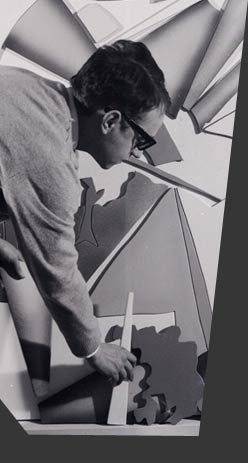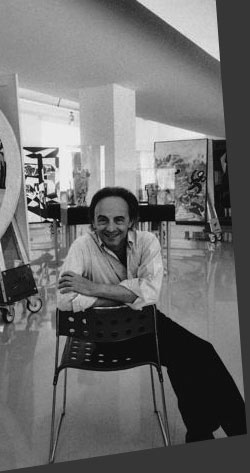Vittorio Sgarbi
Ugo Nespolo's artistic path is undoubtedly an example, mostly if we consider that he finally touched stable points, and the wholeness of both thoughts and practice, and that it will be really difficult to deny it in his future career. He's an example, mostly of all, because of his method in carrying on a dialogue with the basical concepts an artist must necessarily' eel with expression, communication mass society.
But also for living interiorly the deep contradictions of the most official and trusted Avant-Garde, of which e became an opponent in unsuspected (and more difficult) times: doing it, in that period, meant a declaration of war against the main cultural establishment. Nespolo lives the young inebriation of Avant-Garde in his Turin, a city that until the Sixties kept itself out of the most innovative artistic experimentation, representing, in general national imaginary, the foggy grey of industry, the alienating repeating of factory workers 'job. He began his artistic life on the wave of a new relationship with society, in which art is no more entire of itself, but opened to real. world and mass communication, as in Pop Art.
He never interrupted the intellectual relationship with some parts of historical Avant-Gard, as Futurism not the heroically "événementiel" one we find in Boccioni, but the systematic one we can see in Balla and Depero, which validity he considers unchanged). He adopted a new intellectual dimension for the artist: mobile, multitasking, considering moviemaking a frequent occasion for artistic expression; it's easier to see it in his work, much more than in artists who can, someway, being compared and considered similar to him, as Mario Schifano. Carrying all this "baggage" on his shoulders, he lived the season that turned Turin into the international capital of Avant-Garde: Poor-Art.
He took the chance as a true explorer of expression, catching tears of pure originality. But, suddenly, the game is over: very soon Nespolo discovered that what should have been the denial of market, museums and academies, was, actually, a new way to relaunch them.
When the originality of the new proposal is over, Poor Art repeats itself obsessively, ming into commercial, museal, academic matter, with, eat pleasure of the "Lider Waximo" who built all the theory up. When very few artist do, Nespolo wonders if it can be considered as an Avant-Garde or, on the contrary, if it should not be considered as a treachery. He wonders if such an art could deal with a complex an multi-shaped world, or if it's only the intellectual "divertissement" of an elitarian, upper-class world, closed in its ivory towers; or, on the other hand, a very good business, a kind of fetish, useful only in giving great value to the banalization of art. "Reactionary doubts - lords of progress say - This is an attempt to progress". Nespolo doesn't care; decides to do it alone and resumes what he interrupted years before. He went to America to know the real mass-modernity world, even in its folkloristic excess, just to establish a dialogue "au pair" with reality, without the supposition to give lessons to anybody, from a supposed intellectual superiority.
Nespolo is back, and he doesn't care about affirming concepts that could have revolutionary consequences, as they attempt to the roots of the "grand milieu" of commercialized and musealized progress: it's the artist who must put himself at world's disposal, not vice-versa. Balla and Depero understood it well when, in 1915, they turned the starting elitism of Futurism in a program of reconstruction of the universe where art is the system but also the decoration of the world, going into everybody's life and habits, in all its aspects in all possible application. Modern World asks art for a style, a formal taste to show itself both to present and past a kind of presentation card. This is the real Avant-Garde, the purest one, and the most innovative: creativity is the artist' s method to realize it, an alternative to "serious" industrial design.
Nespolo recovers Balla and Depero's "universal grammar" and refresh it at the light of Pop Art, even in those compositions that lay on reversible works, with an infinity of possible variations. We can consider, for ample, Nespolo's engravings, full coloured, with squared frames, similar to first childhood toys.
Someone could notice a resemblance with Alighiero Boetti's Analphabets: he was from Turin too, and he was an absolute painter of Pop Art. It's just appearance: both two base their âapparelsâ on modular systems, patterns and elements which sequences are supposed to be changed. The way he consider the objects, however, it's really different, still artisanal, even considering the mechanism of the solutions, industrially reproducible, in Nespolo, with articulated forms and glazed colours that want
to show a style, a way to give the world a shape to make it happier, to make us happier, asking our emotion and participation to the game. This attitude is strongly conceptual in Boetti, so aseptic, as it intended to limit the craft in the shape, in the physical dimension, and in its visual pleasantness, as if the game could compromise the priority of mental reflections, the roots of all the aesthetic operation.
For Boetti, the object it's a pretext, a way to get something different; for Nespolo, it's an aim, selfsufficient, complete in its wholeness, as a microcosmos.
Two opposite worlds, maybe without the possibility to communicate. A recent happening confirmed that the free construction of Nespolo's universe is still held by courageous thoughts, free from conformity and convenience. Rome, October 2007. An anonymous performer, soon identified as Graziano Cecchini, coloured with bloody red Trevi Fountain's water. An unexpected, fascinating show, well known all around the world, that offended "great people" of culture, the "good-thinkers" of art, addicted to museification.
Ony few voices are so brave to express in favour of this provocation, so perfect in reminding the spirit of historical Avant-Gard, the real one, that of Marinetti and Duchamp, not the pale intents of their fool imitators.
One, it's my voice. The other one, is Ugo Nespolo's voice. It couldn't be different from this.
(From the book: Nespolo Antologia, Galleria dâArte Orler, Schola del'Arte del Tiraoro e Battioro, Campo San Stae, Venezia, 2008, Techne Editore, Venezia)



